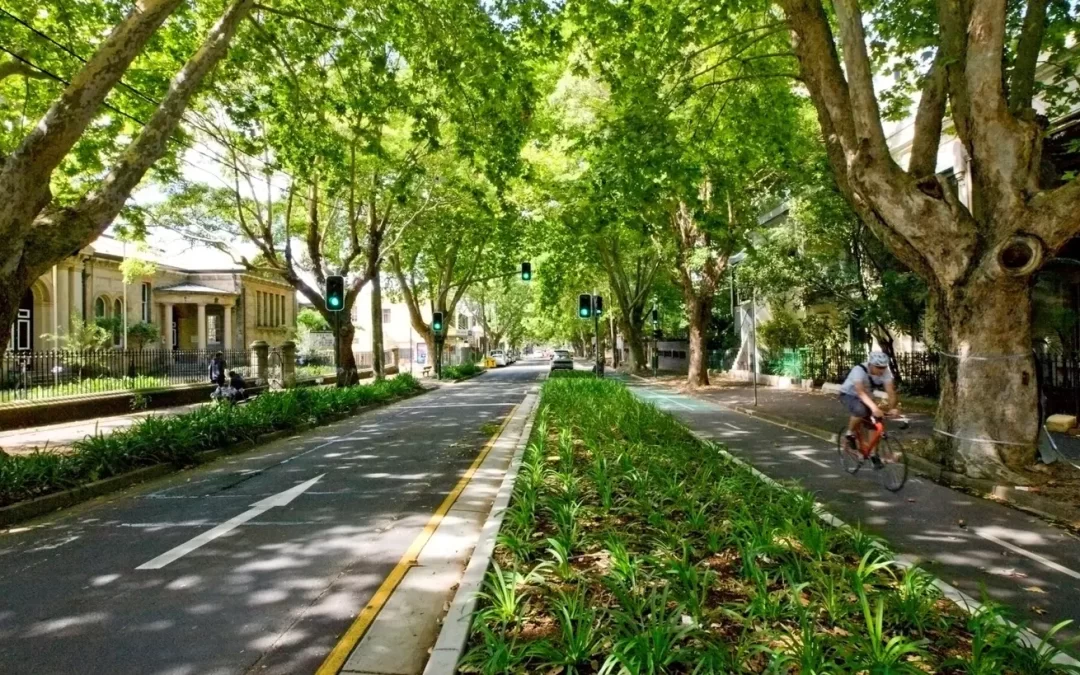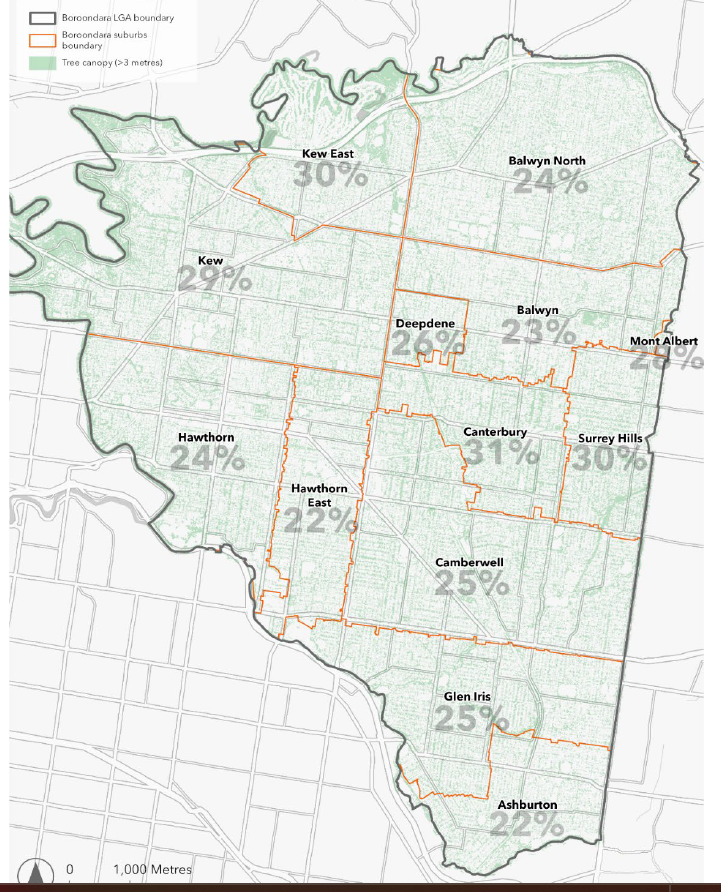The role canopy trees play in providing shade and countering the urban heat island effect.
Image credit: GroupGSA
Tree Canopy
The tree canopy in Boroondara includes trees in streets and transport corridors, parks and nature reserves, private gardens, waterway corridors, schools, and community gardens. It includes all trees and shrubs over 3 metres, from hedges and formal avenues to large old veteran trees.
Canopy cover is defined as the percentage of an area covered by the canopies of all trees (on public and private land) when viewed from directly above. Canopy cover is a useful and commonly used measurement that allows areas with lower canopy cover to be identified and the gains and losses in tree canopy over time to be monitored.
Boroondara covers an area of 60 km2, and currently, around 15.4 km2 is covered by canopy. This is a good canopy cover for an inner-city municipality, but it still falls short of the State Government’s target for 30% coverage across Melbourne.
Boroondara also needs to factor in the loss of trees from major projects, such as North-East Link and Level Crossing Removal, increased housing density, larger single dwellings, and the routine removal of trees as they age and decline. (Strategy p9)
Importance of Tree Canopy
There are many benefits. A healthy tree canopy can be thought of as an “urban forest” which
- provides shade, reduces urban heat island effect
- absorbs pollutants, enhances air quality
- reduces stormwater runoff, helps prevent flooding
- provides habitats for wildlife, fosters biodiversity
- beautifies streetscapes and landscapes
- supports mental health, encourages outdoor activities
- increases property values, attracts businesses, increases foot traffic
- reduces energy consumption for cooling. (City Green Urban Landscapes Solutions)
Threats
Boroondara’s tree canopy, although one of the densest in Greater Melbourne, is also at risk from major developments like North-East Link, densification, trends to larger housing stock with smaller gardens, and climate change. The maps below show that the suburbs with the greatest tree cover (Canterbury and Surrey Hills) also tend to be the suburbs experiencing some of the greatest loss. (Strategy pp 13-15)
Have your say
Have your say on Boroondara Council’s new Tree Canopy Strategy and Action Plan at https://engage.boroondara.vic.
Appropriately, the Boroondara Council seeks to “protect and expand Boroondara’s tree canopy cover”. The Lighter Footprints Forest Working Group, however, desires the proposed Strategy and its Action PLan to be as strong as possible to optimise the chances of a “growing, resilient, and thriving urban forest and expanding tree canopy.” (Strategy p 17)
The survey
To ‘speak for the trees’, please complete the survey here which takes about 5 minutes. The survey is an important opportunity to support increasing tree canopy. Some are opposed. It is a minimal survey and does not directly address specifics in the Strategy. But Question 6 “Feel free to share any other comments you have about Boroondara’s trees” provides an opportunity to make specific points. So if possible, download and read the Strategy and the Action Plan and attend a drop-in session to ask questions or make your main point in person. The survey closes at 5 pm Monday 24 June 2024.
Drop in sessions
- Wednesday 5 June 2024 11:00 am to 1:30 pm: Central Gardens (at the picnic shelter), Henry Street, Hawthorn
- Wednesday 12 June 2024 4:00 pm to 6:00 pm: Camberwell Library, 340 Camberwell Road, Camberwell
Some points to consider
The following points could be used as part of your response to Q6 of the survey or your questions and comments at the drop-in sessions
The Council is to be commended for reviewing its Tree Protection Local law and developing a new Tree Canopy Strategy. However, Boroondara’s tree canopy is threatened and in decline. Urgent and strong action is required.
- Boroondara’s tree canopy cover in 2022 was 25.7 percent. The Climate Action Plan set a target of 30 per cent by 2030 which aligned with the Victorian Planning Authority’s target of 30 percent. With a tree canopy target of only 27 percent by 2040, the new strategy is inconsistent with both of these targets.
- The Strategy notes that each year “700 canopy trees are removed from private land and 800 trees are removed from our streets and parks” yet only 2000 are planted each year on streets and in parks. This number of new trees is unlikely to compensate for the loss of mature tree canopy. For example, a study in the City of Unley SA found that the “growth of existing trees contributed five times as much new tree canopy cover as newly planted trees that have reached a height of 3m, and canopy coverage losses from tree removal and pruning are the equivalent of approximately 78,900 newly planted trees reaching 3m in height (299,917m2).”
- The Strategy and its Action Plan do not undertake to lobby the State government to modify building regulations so that local governments may require the gardens of blocks of a certain size to contain some canopy trees. At the moment, the regulations require 20% of a new houseblock to be permeable (allow water through), but the entire ‘garden’ can be covered in gravel and there is no requirement for grass, shrubs or trees. In the meantime, the Council should prioritise Strategic Actions number 1.2.1 Develop and implement a program to identify and undertake landowner and land manager engagement and collaboration to increase tree-planting opportunities and 2.1.6 Investigate and draft an amendment to the planning scheme to set minimum standards for tree planting on private property.
- The Strategy states that “disincentives to comply with tree protection and retention requirements of the Boroondara Planning Scheme and Tree Protection Local Law are inadequate” but has no reference to increasing penalties for illegal removal of canopy trees. The current fine proposed – the maximum 20 penalty units ($3840) – is inadequate to deter developers, should be dramatically increased and should reflect the value of the tree. The Strategy and its Action Plan should include working with the Victorian Local Governance Association to lobby the State Government to dramatically increase the number of penalty units so that the disincentive is realistic. We do note however that the draft Boroondara Tree Protection Local Law states “In response to submissions made to the Service Delegated Committee meeting of 13 May 2024, it is recommended that Council continue to advocate to the State Government for greater penalties for offences committed under the proposed local law and for metropolitan-wide tree controls to be introduced through the Planning Schemes” and “In addition to advocating for an increase to the financial penalty, consideration should be given to the use of Planning Scheme controls which would also provide for greater enforcement approaches under the Planning and Environment Act 1987.” We are encouraged by these statements.
- The study Urban tree protection in Australia is a most valuable resource and shows what other LGAs are doing around the country including bonds up to $100,000 to enhance protection, and sign shaming where trees have been illegally removed.
- Council could consider reducing the trunk circumference for trees requiring a permit for removal from 150 cm to 50-80 centimetres thereby allowing more young trees to grow into canopy trees.
- The Strategy, its Action Plan and Tree Protection Local Law fail to provide neighbourhoods with notice of removal. In the way that building modifications require planning notices to be displayed, the same should be required for the planned removal of a canopy tree.
- The Strategy, its Action Plan and Tree Protection Local Law fail to clearly specify the consequences for poisoning or pruning canopy trees without Council approval.




